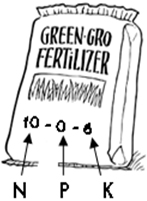<< Back to Fertilizer Law main page
Best Practices for Fertilizer Use
The District’s Fertilizer law outlines how to best apply fertilizer to minimize environmental impacts to our waterways. Most established lawns do not need fertilizer. Rain and too much watering can carry fertilizer into storm drains that flow directly into Rock Creek and the Anacostia and Potomac Rivers. To save money and get the best results, test the soil and only use fertilizer to provide nutrients that are found to be lacking. Learn more about the environmental impacts of fertilizers.
The following specifications are required of lawn care professionals and are voluntary for residents applying fertilizer to lawns and other grassy areas in the District.
Do NOT apply fertilizer under these conditions
- Between November 15 and March 1;
- Within 15 feet of a waterbody (e.g., a river, stream, creek, wetland, storm drain, or drainage ditch). This buffer area may be reduced to 10 feet if fertilizer is applied with a drop spreader, a rotary spreader with a deflector, or a targeted spray liquid;
- When it is raining, 24 hours before it is expected to rain, when the soil is saturated, or when the ground is frozen, which could cause runoff; and
- In excess of the legal rates.
Best Management Practices:
- Apply only in an amount consistent with the District’s annual recommended rate outlined in the next section;
- Apply only when the soil is sufficiently wet to immobilize the fertilizer and prevent runoff;
- Do not apply on hard surfaces, such as sidewalks, patios, and driveways. If fertilizer spills or lands on hard surfaces, promptly sweep it back onto turf or return it to a proper storage container; and
- Store in a closed, waterproof container that is placed indoors or raised above the ground.
Annual Recommended Application Rates:
- Phosphorus: Do not apply fertilizer containing phosphorous unless it is recommended by a soil test taken within the past three years. Instead use low-phosphorus fertilizer that is less than 0.67% phosphate by weight; and
-
Nitrogen: Only apply fertilizer containing 20% or more of slow release (water insoluble) nitrogen. Do not exceed 80% of the annual recommended rate for total nitrogen, and only apply at the following rates:
- Less than 0.7 pounds of water-soluble nitrogen per 1,000 square feet; and
- Less than 0.9 pounds of total nitrogen per 1,000 square feet.
Nitrogen Fertilizer Application Schedule
Pounds of nitrogen applied per month for every 1,000 square feet
|
Grass Type |
May – early June |
June – July |
Aug. |
Sept. |
Oct. – Nov. 15 |
Maximum Yearly Nitrogen Use |
|
Tall fescue |
0.5 – 0.9 lb** |
0 |
0 |
0.7*– 0.9 lb** |
2.7 lb |
|
|
Kentucky bluegrass
|
0.5 – 0.9 lb** |
0 |
0 |
0.7*– 0.9 lb** |
2.7 lb |
|
|
Fine fescue |
0.5 lb |
0 |
0 |
0.7*– 0.9 lb** |
0 |
1.4 lb |
|
Zoysiagrass |
0.7*– 0.9 lb** |
0.5 – 0.9 lb** |
0 |
0 |
0 |
1.8 lb |
|
Bermudagrass |
0.7*– 0.9 lb** |
*** |
0 |
0 |
2.7 lb |
|
* 0.7 lb if applying water soluble (not slow release) nitrogen (e.g., urea and ammonium sulfate).
** 0.9 lb if applying a combination of water-soluble and slow release fertilizer. Turf fertilizer products manufactured for use in the District must contain a minimum of 20% slow release nitrogen, and if used according to the label directions, each application will contain no more than 0.9 lb of total nitrogen per 1,000 square feet.
*** For Bermudagrass: Optional application of 0.5 – 0.9 lb by mid-August.
How to Read Fertilizer Labels
All fertilizer packages are labeled with three bold numbers that show the percentage by weight of key nutrients that contribute to plant growth and health. They are always listed in this order: N-P-K.
N - Nitrogen contributes to the growth of shoots and healthy, green leaves. Make sure it is at least 20% slow release.
P - Phosphorus encourages root development and cellular functions. Do not use fertilizers that contain phosphorus unless a test shows that the soil is deficient.
K - Potassium, sometimes called potash, encourages root development and increases stress tolerance and disease resistance.
For example, a 25-pound bag of low-phosphorus fertilizer marked “10-0-6” has 2.5 pounds (10%) of nitrogen, 0 pounds (0%) of phosphorus, and 1.5 pounds (6%) of potassium. The remaining 21 pounds (84%) are filler, or inert ingredients, that help disperse the chemicals.

